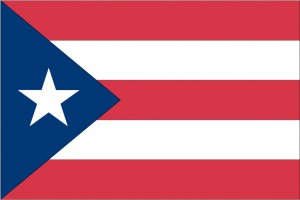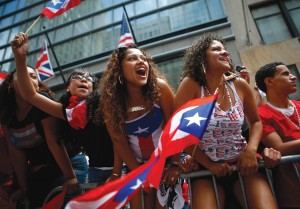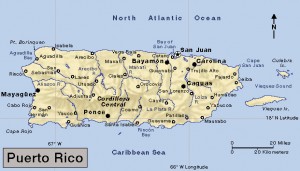Puerto Rican Day Parade: ¡Boricua!
Tuesday, June 13th, 2017June 13, 2017
On Sunday, June 11, the 60th National Puerto Rican Day Parade was held along Fifth Avenue in the New York City borough of Manhattan. The parade, attended by some 2 million people, ran from 44th Street to 79th Street, a stretch of city bedecked and fluttering with the reds, whites, and blues of the Puerto Rican flag. The parade honors the 3.5 million people of Puerto Rico and the roughly 5 million people of Puerto Rican descent in the mainland United States. Puertoriqueños (Puerto Ricans) often identify themselves as Boricuas, a word derived from Borinquen, the Taíno Indian name for the island of Puerto Rico. Spanish is the main language used in schools in Puerto Rico, but students are also taught English.

The Puerto Rican flag, first flown in 1895, became the commonwealth’s official flag in 1952. Credit: © Dream Maker Software
The theme of this year’s parade—the culmination of a week-long celebration of Puerto Rican culture—was “Un Pueblo, Muchas Voces” (One Nation, Many Voices—in Spanish, pueblo can mean nation, people, or town). The parade was preceded by an official golf outing, a ceremony awarding 100 $2,000 college scholarships, a parade Mass, a gala banquet, and the annual 152nd Street Cultural Festival in the Bronx. For good measure, the 33rd annual New York Salsa Festival took place in Brooklyn the day before, on Saturday, June 10.

The National Puerto Rican Day Parade in New York City draws millions of spectators each year. Credit: © Eric Thayer, Reuters/Landov
The National Puerto Rican Day Parade promotes art, culture, and education, and pays special tribute to prominent figures of the Puerto Rican community. This year’s honorees included Grand Marshal Gilberto Santa Rosa, “El Caballero de la Salsa” (The Gentleman of Salsa); Queen Lana Parilla, an actress; Padrino (godfather) Iván Rodríguez, a former baseball star who will be inducted into the National Baseball Hall of Fame in July; and Madrina (godmother) Iris Chacón, a popular singer and actress. Other honorees included Olympic gymnastics gold medalist and “Dancing With the Stars” champion Laurie Hernández and the Puerto Rican National Baseball Team. “Team Rubio”—so-called because the ballplayers dyed their hair rubio (blond)—enjoyed a strong run through the 2017 World Baseball Classic before losing the championship game. Puerto Rico is part of the United States, but Puerto Rican sports teams often compete separately in international competitions.
This year’s parade celebrated the 100th anniversary of the 1917 Jones Act, U.S. legislation that made Puerto Ricans American citizens. This year’s honored town was western Puerto Rico’s Hormigueros. Cleveland, Ohio, and its large Puerto Rican population was this year’s honored stateside city. Other U.S. cities with large Puerto Rican communities—all with their own Puerto Rican parades or festivals—include Boston, Chicago, and Philadelphia. New York City’s first Puerto Rican Day Parade took place in 1958.

Puerto Rico is one of the largest islands that lie between Florida and South America. Click to view larger image Credit: WORLD BOOK map
The United States took control of Puerto Rico during the Spanish-American War of 1898. The island became an autonomous (self-governing) part of the United States in 1952, when it was given commonwealth status. Its official name is the Estado Libre Asociado de Puerto Rico (Associated Free State of Puerto Rico). Since 1967, Puerto Rico has held several plebiscites (popular votes) on whether it should remain a commonwealth or become a U.S. state or independent. The last vote took place on June 11, 2017, the same day as the New York City parade. In that non-binding poll, Puerto Ricans overwhelmingly chose to become a U.S. state. A number of financial and political problems stand in the way of statehood, however, and Puerto Rico’s status is not likely to change anytime soon.


